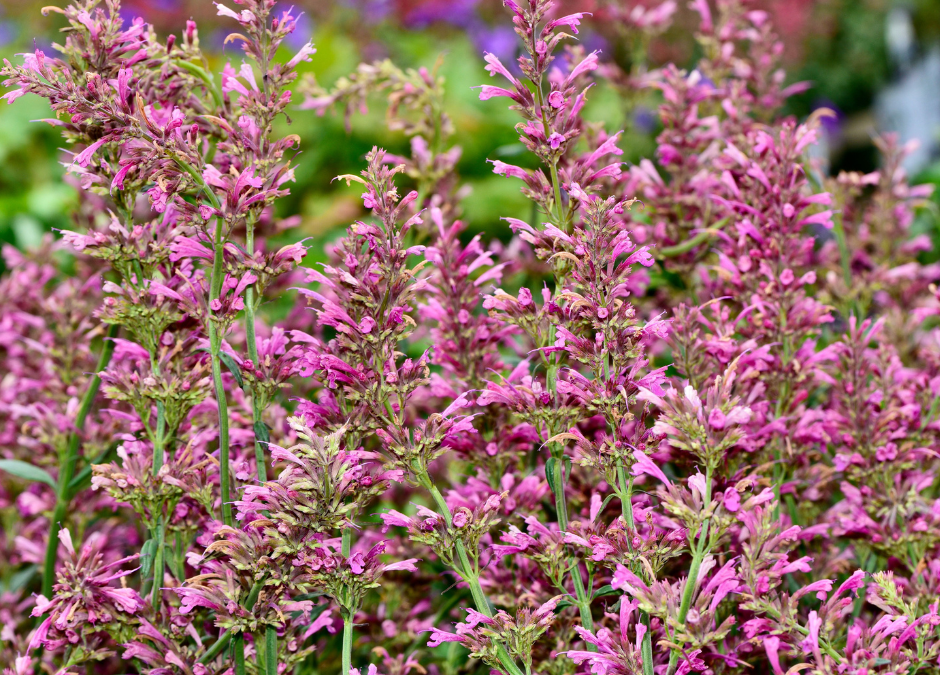If you are looking for a heat loving plant tough enough to handle our San Antonio summer temperatures that offers copious amounts of flowers for the pollinators to enjoy, you might want to take a look at agastache (“ah-GAH-stah-kee”).
10 Quick Characteristics and Needs of Agastache
- Light Exposure: Full sun to partial sun
- Soil: Adaptable to even poor soils, but MUST have good drainage. Use raised beds or containers if you have heavy soils.
- Fertilizer: Not needed (too much can inhibit flowering). If anything you can added well-rotted compost the following season.
- Water Needs: Regular water during first growing season, then, quite drought tolerant once established.
- Bloom Time: Late spring – early fall, spikes of small tubular flowers, profuse bloomer.
- Bloom Color: Orange, red, purple, blue, pink, yellow, white and all hues in between
- Fragrant: Foliage and flowers have a sweet minty-licorice scent
- Pollinator Attractor: YES! Look for hummers, butterflies, bees, and birds.
- When to Plant and Seed: Seed in early spring, once danger of frost has passed, or start indoors in January (many plants will bloom from seed planted that same year). Plant transplants early spring up until early summer.
- Pests: Resistant to deer and rabbits.

More About Agastache
You have many options when it comes to choosing an agastache that will be perfect for your landscape or container gardens. Some grow tall and upright, reaching heights up to four feet, which makes a great option for a focal point. Others have a more compact, bushy form, which would be ideal for a low-growing border plant.
The mint-scented flower spikes of agastache bloom for a long period of time. You can expect to enjoy their flowers from late spring through early fall. They come in a multitude of colors and add a brilliant splash of color in sunny areas of your landscape.
Foliage of Anise hyssop is edible and can be sprinkled in salads, used to decorate cakes, or added to drinks. It’s best to harvest tender, young growth for culinary purposes. The flavor is a mild, sweet, licorice. Both the fuzzy spiked flowers and foliage have a sweet minty-licorice scent.

Pollinators and Agastache
Now let’s talk about the pollinator activity that agastache possesses. Laura Jarvis, of The Butterfly Landing, found that the Seedaholic website totes agastache a “‘wonder honey plant’, as it produces a copious amount of nectar for bees and butterflies to feast upon.” Because agastache continues to bloom late in the season, the bees get a bonus ‘load up’ on nectar before winter rolls in, giving them honey reserves. An extra bonus is that in fall and winter, goldfinches and other small birds love the seeds.
Laura is a great source for knowledge about plants that really serve our local pollinators as she always carefully observes each plant she grows as well as documents the pollinator activity that surrounds them. She raves about the activity she gets with agastache. When Laura tells me a plant is a great pollinator plant, I believe her!

Winter Protection Tip for Agastache
Although agastache is cold hardy in zones …..A winter protection tip you need to know is that you should leave the bare stems to stand all through winter. Don’t prune after a freeze or do any winter ‘clean up’. The stems actually provide extra nutrients to the crown of the plant and help to protect it against winter cold. When spring arrives, that is the time to cut off the woody stems, just above the mound of new growth.
Hope you’ve enjoyed learning about this tried and true, Texas approved pollinator plant.
~The Happy Gardener, Lisa Mulroy

